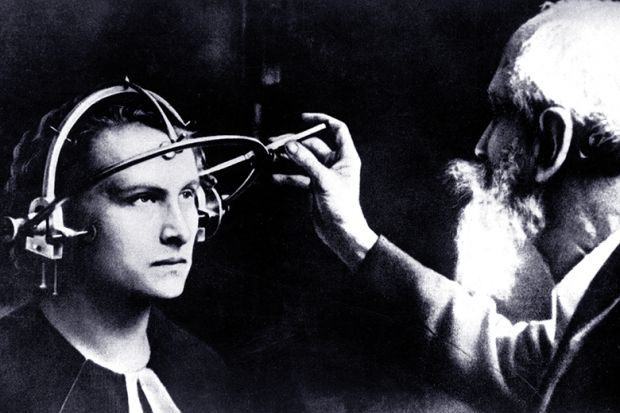Racism’s core belief is that human populations can be divided into distinct groups, ranked hierarchically, primarily on the basis of skin colour and alleged differences in behaviour. When pressed to justify these claims as anything other than naked prejudice, racism snatches, distorts and misquotes often only half-understood concepts and generalisations. While it may point to cultural differences – in religion, clothing or diet – for most of the past two centuries it has focused on biology.
To put it in modern terms, scientific racism insists that human populations are constituted of genetically separate races and that these genetic differences underlie behavioural differences, notably in intelligence. These claims seemed buried for two decades after 1945 in the ashes of the Nazi concentration camps. However, they re-emerged in the US in the early 1970s in the work of psychologists arguing that differences in IQ between “Caucasians” (that is, White European-Americans) and African Americans were genetically determined. Although these assertions were energetically rebutted by geneticists and critics of IQ theory, such scientific racism was merely dormant, not dead, and the dramatic advances that have followed from the sequencing of the human genome at the start of the present century have re-energised the old arguments. Despite the insistence by the successful gene sequencers that their findings confirm that there is only one race – the human race – arguments for genetically based race differences are once more becoming strident.
Prominent among the propagandists for the new racism has been a British-born but US-based science journalist, Nicholas Wade, whose book, A Troublesome Inheritance: Genes, Race and Human History, published in 2014, argued that genomic differences could be used to demonstrate the existence of five distinct human races, with the usual hinted-at corollary of differences in intelligence between them. Unsurprisingly, his five are Africans, East Asians, “Caucasians”, Native Americans and Australian Aborigines. Although more than 100 biologists signed a letter in The New York Times rejecting Wade’s claims, they continue to inform racist discourse. Thus, in his defence of Wade’s book, the libertarian political scientist and theorist of the underclass Charles Murray bet that Wade’s genomic case was so solid that its critics would be left able to disagree only with its unpalatable social implications.
Not so, say leading evolutionary biologists, genomicist Rob DeSalle and palaeoanthropologist Ian Tattersall, in their new book. In comprehensively dissecting and refuting Wade’s scientific claims, they ensure that Murray loses his bet. The two have teamed up before, in their earlier, pre-Wade book Race?: Debunking a Scientific Myth (2011), and the new one follows closely the earlier pattern, reserving its final chapters for a specific, no-holds-barred exposure of Wade’s seven fundamental errors – mistakes, as they put it, that are “routinely committed when genomics and genetic information are used both to examine the biological basis for human races and…[as] justification for reifying race as a biological reality”.
What precedes this demolition job is a masterclass in taxonomy and its methods, evolutionary theory, population and molecular genetics, ancient DNA sequencing, palaeoanthropology and patterns of human migration. It’s not always an easy ride, even for someone with a basic knowledge of biology, but the authors are experienced public educators and have an accessible, reader-friendly style.
A central concern of the early chapters is the taxonomic question: how to classify species and, within species, their sub-units – that is, races. To start with, species, usually defined as a group of organisms capable of exchanging genes and interbreeding, producing fertile offspring. Humans – Homo sapiens, in the Linnaean classification – are a distinct species; we can, and do, interbreed, demonstrated symbolically in the public enthusiasm for the recent royal wedding. As so often in biology, the species definition is fuzzy at the edges, as witness the unexpected finding that some 40,000 years ago ancient Hom.sap. also interbred with their now extinct Neanderthal cousins, so many of us carry a percentage of “Neanderthal genes”.
But it’s when we come to “races” that the definitional problem gets far worse. “Race” is used quite loosely in everyday speech and more formally defined as a group of humans based on shared physical or social qualities. These are in essence social definitions; for biologists, a race is a subgroup that is reproductively isolated, by geographical or social separation, from others of the species and, as a consequence of this isolation, begins over time to differ genetically. DeSalle and Tattersall devote considerable space to discussing just how much gene variation – that is, changes in the DNA sequence – might be required to define a distinct race, and come to the unsurprising conclusion that the answer is as long as a piece of string. That’s why a majority of population geneticists have come to regard the very concept as useless, and, above all in the case of humans, refer instead to any individual’s “biogeographical ancestry”, a perhaps clumsy but nonetheless more meaningful phrase, and one stripped of race’s more derogatory connotations.
Linnaeus constructed his classificatory system in the 18th century, committed to the biblical view that species were immutable, fixed and distinct kinds. By contrast, evolutionary biology recognises that all living species, and their extinct ancestors, are derived from a common ancestor some 3 billion years ago, and that the characteristics of present forms can be understood only by tracing their ancestral family trees. Just like a human family tree, such phyletic trees show how closely related any current species is to others – humans to gorillas and bonobos, for instance. Yet a tree showing likenesses can be based either on phenotypic characteristics – that is, observable features – or on DNA sequences. Which is chosen can lead to very different conclusions, a matter of much concern to taxonomists, and DeSalle and Tattersall devote considerable time to discussing the issue of representation – I hadn’t realised the relevance of just how a tree is drawn to the types of conclusion that can be taken from it.
So far, so general; they then turn to the specific case of human ancestry, our relations with our once contemporary but now extinct hominid siblings, Neanderthals and Denisovans, and the out-of-Africa waves of migration that led from our own immediate common ancestors, “mitochondrial Eve” and “Y-chromosome Adam”, to our current planet-wide distribution. They show how, far from these migratory waves leading to genetically distinct races, the evidence points to regular patterns of interbreeding; the human phyletic tree is, they say, reticulated. This is why we end up not only genetically unique as individuals, but with most of the genetic variance between any two of us lying within rather than between the so-called races that preoccupy Wade and his fellows.
DeSalle and Tattersall conclude with a brief “Race and Society” epilogue, somewhat detached from the rest of the book, which both recognises the deep-seated racism of white Americans towards their black co-citizens and expresses a hope that it is diminishing among the young. They saw the Obama election as an indicator of this change, only to be brought crashing back to earth with Trump and the neo-fascist alt-right. In their concluding words, “As science, race may (or should) be a dead issue; but it shows zombie-like tenacity on the social and political fronts.” It is hard to disagree.
Steven Rose is emeritus professor of neuroscience at The Open University.
Troublesome Science: The Misuse of Genetics and Genomics in Understanding Race
By Rob DeSalle and Ian Tattersall
Columbia University Press
224pp, £27.00
ISBN 9780231185721
Published 19 June 2018
The authors
Rob DeSalle, a professor at the American Museum of Natural History (and curator in the Sackler Institute for Comparative Genomics), spent his formative years in the farmlands of Illinois. He studied at the University of Chicago before going on to graduate school at Washington University in St Louis.
Ian Tattersall, curator emeritus in the AMNH’s Division of Anthropology, was born in the UK but grew up in Uganda and Kenya. He was an undergraduate at Cambridge, he recalls, “at an exciting moment when paleoanthropology was coming to terms with the discoveries [from the Olduvai Gorge in Tanzania]”, and a graduate student at Yale, “then an epicentre of research on the long history of human emergence”.
It was while serving as co-curators of the AMNH’s Hall of Human Origins that DeSalle and Tattersall began collaborating on a series of books: Human Origins: What Bones and Genomes Tell Us About Ourselves (2007); Race?: Debunking a Scientific Myth (2011); and A Natural History of Wine (2015). “We have both been interested in human evolution and diversity,” explains the former, “and the race question is a logical outcrop of these topics. It is perhaps one of the most important things to clarify in modern biology.”
Asked if science is operating today within a hostile environment, Tattersall responds that “there is always room for complaint, in terms both of funding and public acceptance; yet science always surges ahead. I look forward to the day when everybody takes for granted that it furnishes no useful basis for recognising human races”.
“All one needs to do,” adds De Salle, “is walk through the AMNH halls and see the children who are mesmerised as I was in my earlier years by the beauty of nature displayed in the halls. The problem is we grow up and lose this enthusiasm.”
Matthew Reisz
POSTSCRIPT:
Print headline: Race is our ‘zombie debate’
Register to continue
Why register?
- Registration is free and only takes a moment
- Once registered, you can read 3 articles a month
- Sign up for our newsletter
Subscribe
Or subscribe for unlimited access to:
- Unlimited access to news, views, insights & reviews
- Digital editions
- Digital access to THE’s university and college rankings analysis
Already registered or a current subscriber?








